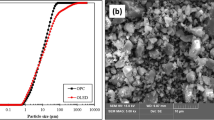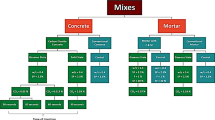Abstract
In this study, the ability to absorb CO2 in concrete, in terms of carbonation reaction, was evaluated by utilizing organic light emitting diode (OLED) waste glass as a cementitious binder. The substitution level was set 10%, 20%, and 30% by weight of the binder, and water to binder ratio was kept at 0.4 for all mixes. Prior to estimate the concentration of CO2 uptake, an influence of OLED replacement on pozzolanic reactivity and thus strength development of concrete was investigated. CO2 absorption was calculated by molar concentration of carbonatable phases and carbonation depth derived from quantitative X-ray analysis and accelerating carbonation test, respectively. As a result, the blended concrete exhibits a higher strength with an increase of OLED replacement ratio due to the pozzolanic reaction, compared to the control specimen. Also, the content of CO2 uptake for the mixtures was increased with the substitution level of OLED, of which the OLED-mixed concrete was 1.81-2.76 times higher than the ordinary Portland cement (OPC) 100% concrete. This behavior may be attributed to an increased rate of carbonation progress. Therefore, it is concluded that the capacity of CO2 absorption is improved by the use of OLED glass powder as a cementitious material in a concrete mixture.
Similar content being viewed by others
References
Balonis M, Glasser FP (2009) The density of cement phases. Cement and Concrete Research 39(9):733–739, DOI: 10.1016/j.cemconres.2009.06.005
De Weerdt K, Haha MB, Le Saout G, Kjellsen KO, Justnes H, Lothenbach B (2011) Hydration mechanisms of ternary Portland cements containing limestone powder and fly ash. Cement and Concrete Research 41(3):279–291, DOI: 10.1016/j.cemconres.2010.11.014
Du H, Gao HJ, Li W (2014) Pozzolanic reaction of glass powder and its influences on concrete properties. Proceedings of 23rd Australasian conference on the mechanics of structures and materials, December 9–12, Byron Bay, Australia
Dyer TD, Dhir RK (2001) Chemical reactions of glass cullet used as cement component. Journal of Materials in Civil Engineering 13(6): 412–417, DOI: 10.1061/(ASCE)0899-1561(2001)13:6(412)
Hashimoto K (2019) Global temperature and atmospheric carbon dioxide concentration. In: Global carbon dioxide recycling. Springer, Berlin, Germany, 5-17
Hewlett P, Liska M (2019) Lea’s chemistry of cement and concrete, 5th edition. Butterworth-Heinemann, Oxford, UK
Hossain KM, Lachemi M (2006) Development of volcanic ash concrete: Strength durability, and microstructural investigations. ACI Materials Journal 103(1):11
Jeon BH, Kim HS, Lee SH (2018) A study on the evaluation of the carbonation resistance and properties ternary blended concrete according to replacement ratio of blast furnace slag and fly ash. Journal of the Korea Concrete Institute 30(1):23–30, DOI: 10.4334/JKCI.2018.30.1.023 (in Korean)
Karamberi A, Moutsatsou A (2005) Participation of coloured glass cullet in cementitious materials. Cement and Concrete Composites 27(2):319–327, DOI: 10.1016/j.cemconcomp.2004.02.021
Kashef-Haghighi S, Shao Y, Ghoshal S (2015) Mathematical modeling of CO2 uptake by concrete during accelerated carbonation curing. Cement and Concrete Research 67:1–10, DOI: 10.1016/j.cemconres.2014.07.020
Kim HK (2017) The appraisal of paris climate agreement and Korea’s response. Environmental Laws Institute 39(2):195–230
KS F 2405 (2010) Standard test method for compressive strength of concrete. KS F 2405, Korea Standards Association, Seoul, Korea (in Korean)
KS L 5201 (2006) Portland cement. KS L 5201, Korea Standards Association, Seoul, Korea (in Korean)
Lagerblad B (2005) Carbon dioxide uptake during concrete life cycle: State of the art. Cement and Concrete Research Institute, Stockholm, Sweden
Lee SH, Lee SB, Lee HS (2009) Study on the evaluation CO2 emission-absorption of concrete in the view of carbonation. Journal of the Korea Concrete Institute 21(1):85–92, DOI: 10.4334/JKCI.2009.21.1.085 (in Korean)
Ling TC, Poon CS (2013) Use of phase change materials for thermal energy storage in concrete: An overview. Construction and Building Materials 46:55–62, DOI: 10.1016/j.conbuildmat.2013.04.031
Matos AM, Sousa-Coutinho J (2012) Durability of mortar using waste glass powder as cement replacement. Construction and Building Materials 36:205–215, DOI: 10.1016/j.conbuildmat.2012.04.027
Mirzahosseini M, Riding KA (2015) Influence of different particle sizes on reactivity of finely ground glass as supplementary cementitious material (SCM). Cement and Concrete Composites 56:95–105, DOI: 10.1016/j.cemconcomp.2014.10.004
Pade C, Guimaraes M (2007) The CO2 uptake of concrete in a 100 year perspective. Cement and Concrete Research 37(9):1348–1356, DOI: 10.1016/j.cemconres.2007.06.009
Park BD (2017) International legal issues on post-2020 climate change regime - Focusing on compliance mechanism. The Korean Journal International Law 62(1):37–61
Pereira-de-Oliveira LA, Castro-Gomes JP, Santos PMS (2012) The potential pozzolanic activity of glass and red-clay ceramic waste as cement mortars components. Construction and Building Materials 31:197–203, DOI: 10.1016/j.conbuildmat.2011.12.110
Šavija B, Luković M (2016) Carbonation of cement paste: Understanding, challenges, and opportunities. Construction and Building Materials 117:285–301, DOI: 10.1016/j.conbuildmat.2016.04.138
Shao Y, Lefort T, Moras S, Rodriguez D (2000) Studies on concrete containing ground waste glass. Cement and Concrete Research 30(1):91–100, DOI: 10.1016/S0008-8846(99)00213-6
Shi C, Wu Y, Riefler C, Wang H (2005) Characteristics and pozzolanic reactivity of glass powders. Cement and Concrete Research 35(5): p987–993, DOI: 10.1016/j.cemconres.2004.05.015
Song DS (2019) The renovation of Korean environmental legislation on the new UN framework convention on climate change. Public Land Law Review 85:335–363
Targan Ş, Olgun A, Erdogan Y, Sevinc V (2003) Influence of natural pozzolan, colemanite ore waste, bottom ash, and fly ash on the properties of Portland cement. Cement and Concrete Research 33(8):1175–1182, DOI: 10.1016/S0008-8846(03)00025-5
Toby BH (2006) R factors in Rietveld analysis: How good is good enough? Powder Diffraction 21(1):67–70, DOI: 10.1154/1.2179804
Acknowledgements
This research was supported by a grant (19CTAP-C152028-02) from Technology Advancement Research Program funded by Ministry of Land Infrastructure and Transport of Korean government.
Author information
Authors and Affiliations
Corresponding author
Rights and permissions
About this article
Cite this article
Kim, SK., Jang, IY. & Yang, HJ. An Empirical Study on the Absorption of Carbon Dioxide in OLED-Mixed Concrete through Carbonation Reaction. KSCE J Civ Eng 24, 2495–2504 (2020). https://doi.org/10.1007/s12205-020-0122-2
Received:
Revised:
Accepted:
Published:
Issue Date:
DOI: https://doi.org/10.1007/s12205-020-0122-2




